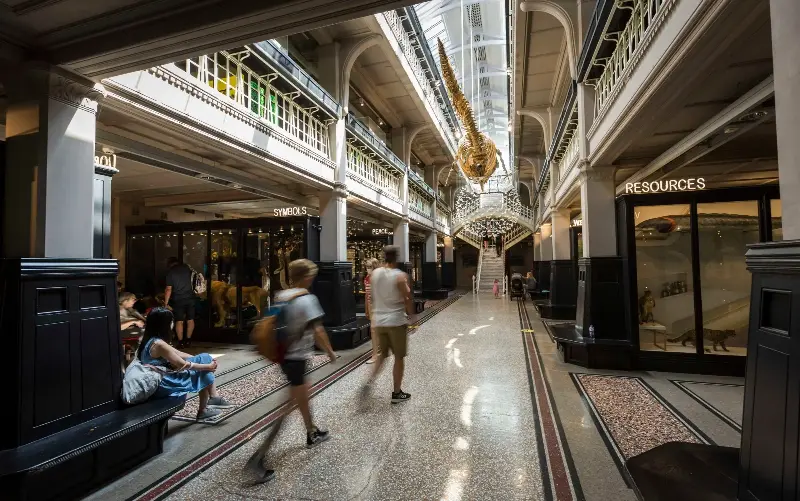
Past mountainous warehouses, down a listless canal, and into the quiet academic quarter with its beige halls soaring into skies that never seem to cease to rain, stands Manchester Museum. With the institution freshly glistening with “European Museum of the Year 2025” status, I ventured in to see if this superlative accolade is justified, immersing myself in ancient earrings, psychedelic rickshaws and the tooth of an 80-million-year-old shark, the mellow rain of Manchester pattering on the roof.
The museum’s purpose is written in the atrium: “To build understanding between cultures and a more sustainable world.” This isn’t really a museum about Manchester, more of artefacts, animals and artworks that have ended up in the museum’s collection, and a mosaic of perspectives from ethnic minority communities living in, studying at, or in some way associated with Manchester. It strives to be “the most inclusive, imaginative and caring museum you’ll ever visit”.
Essentially, the museum is about belonging. It is this bold curatorial line that gives it a distinctive flavour, with each of the four main galleries contributing to the central theme in interesting and surprising ways. I first entered Ancient History, Contemporary Belonging, a gallery of ancient and medieval artefacts from Anatolian earrings to marvellously-preserved Roman playing pieces, ancient Egyptian cat idols to hoards of delicate medieval silver coins.
The rooms are a little over-stuffed, and some of the information plaques positioned so low that all the stooping became exhausting. I had to be economical in what I examined, but this made me worry that I was overlooking some gems, sometimes quite literally.
Despite these gripes – entrance is free, anyhow, so you can always come back – a strong flavour of displacement emerged, a synergy between the migration of ancient historical objects and of people. More topical than ever at a time when George Osborne is reportedly negotiating a “reciprocal, long-term loan” which would send the Elgin Marbles back to Greece, it was hard to peruse the collection without wondering how on earth so many of these rare finds ended up in Manchester and the answers, one suspects, are not always savoury.
You’re encouraged to consider the human stories of migration, the sometimes traumatic tales of persecution, forced upheaval and dreams of a better life that help to explain how a Mesopotamian hair-pin fetched up in front of you.
Many museums now engage in this kind of soul-searching, but here it is taken a step further. Manchester University students of migrant heritage have been invited to respond. The juxtaposition of an “official” plaque next to a personal response presents a person’s lived experience as an echo of the narrative.
On paper, this is fraught with risk, threatening to debase the whole thing into mawkish amateurishness. But many of the responses are in fact profoundly moving, making the galleries feel less lofty and academic than their equivalents in, say, the Ashmolean or the British Museum.
The next gallery focuses on animals that belong – or should belong, if we weren’t doing so much to make the earth uninhabitable. Cinematically lit, with a veritable menagerie of taxidermy and lifelike models, this is an emporium of wonder, at times a cacophony of delighted children’s wails.
It was exhilarating to stare into the eyes of an African hunting dog, a North American woodchuck, or Maude the tigon – a cross between a male tiger and a lioness, once a beloved feature of Manchester’s Belle Vue Zoo – finally on display after 70 long years existing as a rolled-up skin in a storage vault.
Stuck on one glass panel, in stark red letters, is the word “Decolonise!” – signalling its inclusion in the museum’s Decolonise! Trail. Of course, this will make some people groan. But the manner in which it is done, at least, is original. It feels like a Just Stop Oil-style organisation has placed it here; a performative act of self-sabotage.
It’s just one act of curatorial dandyism. Elsewhere, an empty glass box commemorates species that became extinct. In another display, the stuffed heads of tigers and lions loom like phantoms of guilt over black-and-white photographs of hunters.
It’s only when the curatorial voice slips from posing questions to telling you the answers that the device galls. I felt this peering into a surrealist reconstruction of a curator’s office, eerily frozen in time since the 1920s, all mahogany desks and exotic bric-a-brac. It is, we are told, “like a glimpse of our colonial unconscious” – yet all I could think about was how cosy and charming it looked compared with soulless modern offices.
The South Asia Gallery – bright, airy, perfectly spaced – casts a spotlight on the experiences of British Asian communities. Scenes of oppression, violence and starvation under the East India Company and the Raj are included, as one might expect, appearing as incongruously beautiful panels in the atrium. Objects that were “violently plundered”, were are told, have not been included.
One of the most poignant parts of this gallery are the displays that bring to life “hidden” voices within British-Asian communities. The prejudice historically felt by mixed-race Asians is rendered palpable and real. The exhibition on LGBT people of British Asian heritage is particularly moving: their feelings of loneliness, confusion and self-loathing, as well as hope, are all conjured from cuttings from 1990s magazines, help forum notices and leaflets.
A final gallery attempts the same thing (slightly less successfully) from an East Asian perspective. I was fascinated to learn that Manchester has a higher proportion of Chinese émigrés than any other city in Europe. It’s one of the few revelations we get about Manchester itself. I hankered for more on how this great industrial behemoth came to be, and its later metamorphosis into a modern city of culture.
Many, no doubt, would find the emphasis upon displacement, multicultural identity and preserving the environment preachy and over-rehearsed. Some might even declare the whole thing a Trojan’s Horse of woke tosh (when I’d read that the museum has “safe spaces” for anyone who finds the exhibitions traumatising, I did cringe). But Manchester Museum nails its colours to the mast. And it’s only fair to judge something by what it is trying to achieve. Does it succeed on its own terms? Overwhelmingly, yes.
